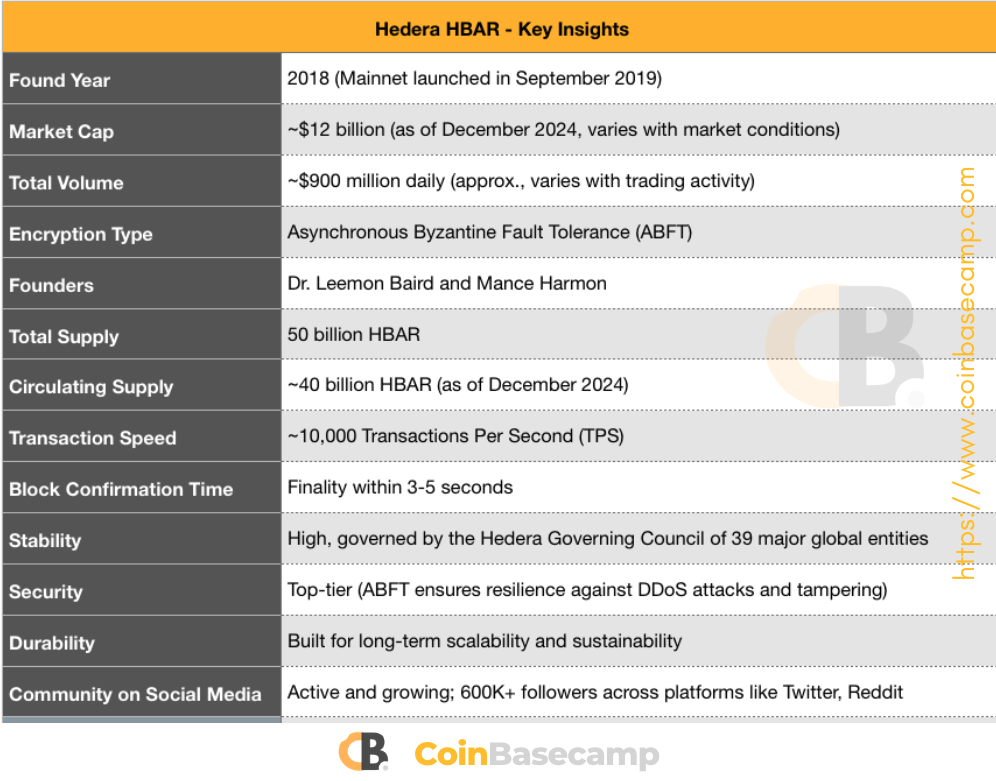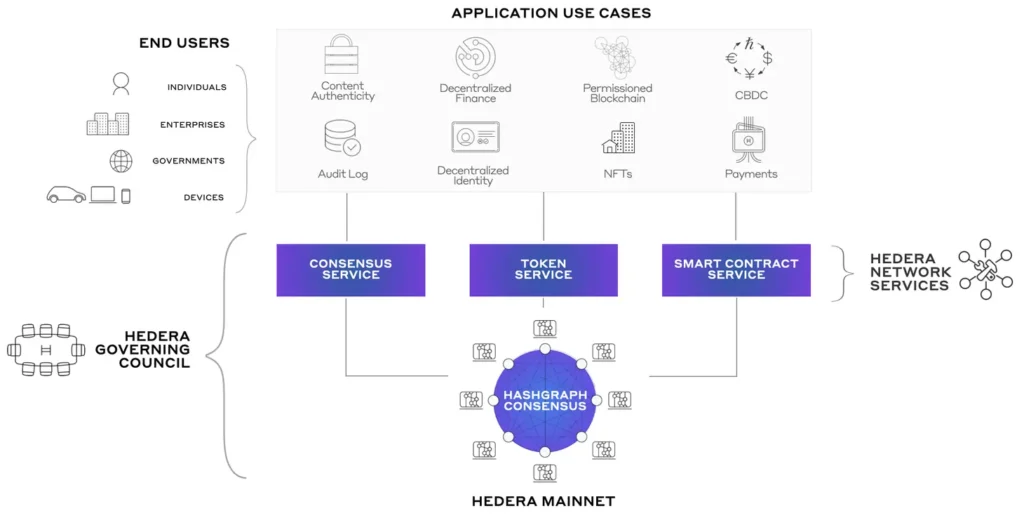1. Introduction to Hedera HBAR
Hedera HBAR is a decentralized public network that aims to provide fast, fair, and secure solutions for the digital economy. It powers the Hedera ecosystem, enabling users to develop and deploy decentralized applications (dApps) with high performance and minimal environmental impact.

2. History and Origin of Hedera HBAR
When Did It Start?
Hedera Hashgraph was officially launched in August 2018, with the public mainnet going live in September 2019. It was developed by Leemon Baird and Mance Harmon, co-founders with a vision to improve upon blockchain limitations.
Motivation Behind Hedera:
- Scalability Issues: Address the slow transaction speeds of traditional blockchains.
- Energy Efficiency: Reduce the environmental footprint of crypto transactions.
- Security and Fairness: Provide a decentralized governance model with robust security.
3. How Does Hedera Work?
Hedera operates on a unique technology called the Hashgraph consensus mechanism, which differs significantly from traditional blockchain systems.
Key Concepts:
- Hashgraph: A distributed ledger that records transactions using a Directed Acyclic Graph (DAG). This ensures faster, more efficient processing.
- Consensus Algorithm: The Hashgraph uses gossip-about-gossip and virtual voting to achieve consensus. This ensures:
- High throughput (10,000+ transactions per second).
- Low latency (transactions final in seconds).
- Provable fairness and security.

source: https://hedera.com/learning/hedera-hashgraph/what-is-hedera-hashgraph
4. Hedera’s Core Features
Transaction Speed
- Processes 10,000 transactions per second (TPS), much faster than Bitcoin (~7 TPS) or Ethereum (~30 TPS).
Low Fees
- Transaction costs average $0.0001—making it suitable for microtransactions and enterprise use cases.
Environmental Efficiency
- A single HBAR transaction consumes less energy than traditional blockchain transactions, making it one of the most eco-friendly networks.
Smart Contracts and Tokenization
- Smart Contracts 2.0: Enables advanced programmability for dApps.
- Tokenization Framework: Developers can create and manage custom tokens seamlessly.
File Service
- Allows for decentralized file storage with cryptographic proof of file integrity.
5. Governance Model
Hedera operates on a decentralized governance model led by the Hedera Governing Council, which consists of up to 39 multinational organizations from diverse industries, including:
- IBM
- Boeing
- Tata Communications
Why Is This Important?
- Transparency: Decisions about the platform are made collectively.
- Stability: Members rotate periodically, ensuring decentralization and fairness.
6. Use Cases of Hedera
dApps and Enterprise Applications
Hedera supports a range of use cases:
- Supply Chain Management: Track goods across the supply chain.
- Identity Management: Securely store and verify identities.
- Payments: Enable instant, low-cost payments.
- Gaming and NFTs: Support high-performance gaming dApps and NFT ecosystems.
DeFi Applications
Hedera’s speed and low fees make it ideal for decentralized finance (DeFi), enabling:
- Decentralized exchanges (DEXs).
- Lending and borrowing platforms.
- Stablecoin transactions.
7. HBAR Token: Purpose and Utility
HBAR has two main purposes:
- Fuel for the Network: Used to pay for transactions, smart contracts, and other services on the Hedera network.
- Network Security: HBAR is staked to maintain the network’s security and integrity.
Tokenomics:
- Total Supply: 50 billion HBAR.
- Circulating Supply (2024): ~30 billion.
- Distribution is designed to ensure long-term sustainability and growth.
8. Security and Performance
Hedera’s Hashgraph technology ensures:
- Asynchronous Byzantine Fault Tolerance (ABFT): Offers the highest level of security.
- DDoS Resilience: The network is resistant to distributed denial-of-service attacks.
- Fast Finality: Transactions are final within 3-5 seconds.
9. Comparison with Traditional Blockchains
| Feature | Hedera Hashgraph | Bitcoin | Ethereum |
|---|---|---|---|
| Consensus | Hashgraph (DAG) | Proof-of-Work | Proof-of-Stake |
| Speed | 10,000 TPS | ~7 TPS | ~30 TPS |
| Energy Use | Very Low | High | Moderate |
| Finality | <5 seconds | ~10 minutes | ~6 minutes |
10. Getting Started with HBAR
How to Buy HBAR:
- Exchanges: Available on platforms like Binance, Coinbase, and Kraken.
- Wallets: Store your HBAR securely using wallets like:
- HashPack (Hedera-specific wallet).
- Ledger (hardware wallet).
- Atomic Wallet (multi-crypto wallet).
11. Challenges and Future of Hedera
Challenges:
- Adoption: Competing against established networks like Ethereum.
- Regulation: Navigating the evolving crypto regulatory landscape.
Future Potential:
- Partnerships with enterprises like Google, Boeing, and IBM signal strong backing.
- Focus on scaling Web3 applications and supporting DeFi ecosystems.
12. Conclusion
Hedera HBAR stands out as a forward-thinking cryptocurrency designed for scalability, security, and environmental sustainability. With its innovative Hashgraph technology and growing adoption, Hedera is well-positioned to become a key player in the decentralized digital economy.
FAQs
- Is HBAR a blockchain?
- No, it uses Hashgraph technology, which is a faster, more secure alternative to blockchain.
- Is HBAR eco-friendly?
- Yes, it consumes significantly less energy compared to other cryptocurrencies.
- What is the main use of HBAR?
- HBAR powers the Hedera network for transactions, smart contracts, and network security.
Don’t miss is our “1 Minute Crypto Guide – Video Series “




